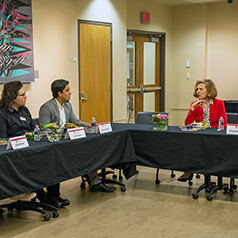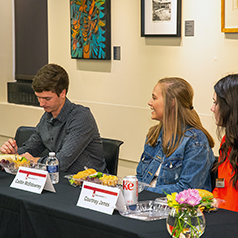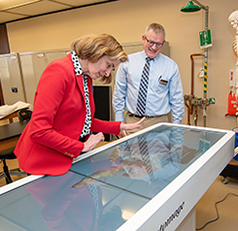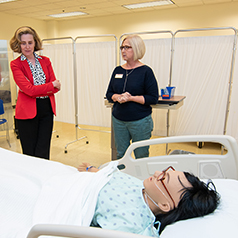IU President Whitten visits campus to hear students share about life as a Red Wolf, faculty Innovative Teaching
An introductory course in psychology as a freshman at Indiana University East piqued the interest of Alexis Williams to the point of steering her toward a future profession.

Students meeting with IU President Whitten on April 14 are Courtney James, Cade Brubaker, Jillian Splawn, Caitlin McEldowney, Addie Brown, Alex Hakes and Manuel Roman.
Now a senior completing her last semester of college, Williams shared what inspired her about that first course and her future plans with Indiana University President Pamela Whitten during a campus visit on April 14.
President Whitten made her third trip to the Richmond campus on Thursday since she was named IU’s 19th president in April 2021 by the IU Board of Trustees. While at IU East, Whitten met with a group of students over lunch in the First Bank Richmond Community Room to talk about their classroom and campus experiences.
The day’s agenda also included sessions with faculty and staff and the new innovative teaching tools available at IU East including the Anatomage Table in the School of Natural Science and Mathematics and a tour of the Virtual Reality and Simulation Learning Spaces for the School of Nursing and Health Sciences.
Williams met with President Whitten in Whitewater Hall Lobby. Williams is from Modoc, Indiana, and is majoring in psychology with a minor in philosophy. She is an Admissions Ambassador and she works in the Office of External Affairs for campus events. Off campus, Williams works for a nursing home as a receptionist and COVID screener, and she is also a hair and makeup artist for special events.

IU President Pamela Whitten talks with seniors Manuel Roman and Alex Hakes about their student experience at IU East.
President Whitten asked Williams about her experience at IU East, including her favorite events, classes, and what she planned to do following graduation.
“Probably my best experience was my intro to psychology course my freshman year,” Williams said. “My professor (Greg Dam) inspired me to study psychology. Now I’m planning on going all six years here – to complete graduate work here at IU East – and to work as a mental health therapist or addictions counselor.”
The countdown to commencement is on for graduating seniors in the Class of 2022.
Fellow graduates Alex Hakes and Manuel “Manny” Roman were two of seven students who met with President Whitten for lunch to have a roundtable discussion on their experience at IU East.
Hakes and Roman shared that there are 29 days – and counting – until graduation.
President Whitten assured the graduates she would also be attending this year’s Commencement Ceremony on Friday, May 13. This will be President Whitten’s first commencement for IU and IU East. President Whitten and IU East Chancellor Kathy Girten will preside over the ceremony and confer the degrees. This year will be Chancellor Girten’s last Commencement Ceremony. Girten recently announced her plans to retire June 30.
The students who met with President Whitten came from a variety of backgrounds and degree programs, and they were eager to share what it is to be a Red Wolf at IU East. Topics ranged from online courses and the potential to offer in-person classes as the impact of COVID-19 continues to decline to concern for rebuilding community on campus, especially for freshman or sophomore students who are not as familiar with campus traditions and events as a result of the pandemic.

Caitlin McEldowney, a sophomore majoring in nursing, discusses student issues with IU President Pamela Whitten as Cade Brubaker, a junior business administration major, and Courtney James, a junior biochemistry major, listen. The students were part of a roundtable discussion with President Whitten during her visit to IU East.
Students shared how faculty have been vital to keeping them involved through coursework and help to make the campus a welcoming environment. There was an exchange of ideas on what the campus or university could do to help students get more involved on campus or university-wide; and what their interests were following graduation.
President Whitten expressed an interest in having the graduates remain in Indiana following graduation. Now a resident of Indiana after moving from Georgia, Whitten shared that she is enjoys living in the state.
Hakes is the president of the Student Government Association. He is a senior double major in Spanish and Political Science, and plans to attend graduate school at IU Bloomington. He lives in Richmond and is from Yorktown, Indiana. His family moved nearby to Cambridge City after he started attending IU East, he said, and his sister is also now a Red Wolf.
“President Whitten is open to hearing about the issues we brought up and each topic was addressed,” Hakes said.
Courtney James, SGA vice president, is from Connersville, Indiana. James, a junior biochemistry major, attended Whitten’s inauguration in November 2021 as the student representative from IU East.
She and Hakes both agreed that talking with President Whitten about IU East was a comfortable experience, including concerns they have or that they hear from other students while in class or as representatives on SGA.
James inquired how students and the campus community could be more involved with sustainability efforts. President Whitten shared that a new sustainability council has been formed and she would meet with the council at the end of the month for its first meeting. She also encouraged James to talk with others on campus to share ideas, to get involved and to be active in sustainable efforts.
“I like how personable President Whitten is. It’s like talking with someone I see on campus every day, and I love the focus she has on students across all campuses,” James said. “She is a humble person that you can speak to on the level of a friend. She has our best interest at heart and you can tell.”
While the students shared concerns for more interaction and in-person classes, and more students to return for campus activities, they also acknowledged the convenience of online courses.
Addie Brown, a senior communications major from Oxford, Ohio, shared her experiences as a student-athlete and online student with President Whitten. Brown also works for the Office of External Affairs and the Writing Center on campus. Her experiences provide the in-person elements she needs, while online courses provide an academic schedule that fits with athletics and work.
During the discussion, President Whitten inquired about Richmond and the opportunities available to students.
Brown, a member of the Red Wolves women’s basketball team, said she enjoys seeing the stands full at games, with fans including students, faculty and staff, but also from the community as well. Now that fans are back after a hiatus during COVID restrictions, she hopes to continue seeing more people at games.

IU President Pamela Whitten uses the Anatomage table during a presentation of Innovative Teaching tools new to the School of Natural Science and Mathematics. Brian Olson, lecturer, shares with President Whitten how the 3D virtual dissecting table is being used in the classroom to teach students in science, nursing or health sciences courses to learn human anatomy.
“It’s the people who make Richmond the nice place that it is to live. I meet people in the community who I wouldn’t have met if I hadn’t have gotten plugged into something here,” Brown said.
Cade Brubaker, a junior business administration and accounting major from Arcanum, Ohio, Jillian Splawn, a psychology major from Fairfield, Ohio, and Caitlin McEldowney, a sophomore nursing major from Versailles, Ohio, all shared the opportunities they’ve had in the community as well as on campus.
Brubaker recently participated in a course project with Jaynne Rivas, assistant professor of management, where students worked with the Richmond Parks Department to improve awareness for its recycling program. He works on campus with the Office of Career Services and Internships.
“The Richmond community is willing to help students a lot if we’re willing to ask,” Brubaker shared with President Whitten.
McEldowney is also a member of the women’s basketball team. She felt the student discussion with President Whitten went well. “It was good to give our faculty the shout out they deserve,” she added.
Innovative Teaching
As part of the visit, faculty from the School of Nursing and Health Sciences and the School of Natural Science and Mathematics shared new advances in teaching innovations they are using in the classroom to enhance student learning with President Whitten.
Brian Olson, lecturer in the School of Natural Science and Mathematics, and Heatherlynn Barrett, laboratory coordinator, demonstrated the Anatomage virtual dissecting table, a state-of-the-art teaching tool allows students to learn human anatomy by providing a life-sized display of the human body. The table is used to help prepare students for careers in health science.
Using virtual controls, an instructor or students may peel back layers of tissue and examine bones, blood vessels and organs. S

IU President Whitten tours the nursing laboratory as Gloria Dixon, assistant professor of nursing, shares how the School of Nursing and Health Sciences is using Virtual Reality and Simulation Learning Spaces.
tudents may even use a virtual scalpel tool to make incisions, cut away portions of the body and inspect different cross-sections of any anatomical structures. Olson demonstrated the Anatomage table, instructing President Whitten on how to the select pathways of the body for study.
“We can go deeper and deeper into the human body,” Olson explained.
In the School of Nursing and Health Sciences laboratories, President Whitten experienced how the school is using virtual reality and simulation to afford students opportunities in clinical reasoning and skill development in a safe environment as part of the learning process.
Karen Clark, dean of the School of Nursing and Health Sciences, led the tour through the nursing laboratories along with Shelly Burns and Gloria Dixon, clinical assistant professors.
IU East opened its Virtual Reality (VR) Lab in January 2019 through a strong partnership with the IU Advanced Visualization Lab (AVL). The group previously assisted the campus with an IQ-Wall, located in the First Bank Richmond Tech Zone in Whitewater Hall, and the first one of its kind installed at an IU regional campus in November 2017. Now the School of Nursing and Health Sciences is expanding its virtual reality with programs chosen based on filling clinical gaps.
Virtual Reality programs recently added to help fill those gaps include a non-English speaking post-partum exercise to help nursing students work with patients through language barriers; an adolescent abuse and drug overdose case; and a tonsillectomy case that developed issues after five days. Burns and Dixon explained that nursing students in their senior year of the program will have more complex scenarios to problem solve using virtual reality.
“This is a safe environment for students to practice their communication and clinical judgement skills,” Dixon said.

